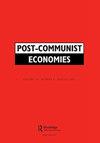Time interval choices in forecasting stock market indices of CEE and SEE countries
IF 2.2
3区 经济学
Q2 ECONOMICS
引用次数: 0
Abstract
ABSTRACT The main objective of this analysis is to investigate how varying the forecast horizon and the input window length for calculating technical indicators affects the predictive performance of different machine learning algorithms on forecasting the direction of change of chosen stock market indices. Ten indices from CEE (Central and Eastern European) and SEE (Southern and Eastern European) countries are chosen for research in an attempt to investigate their behaviour in the light of the behaviour of bigger and more researched markets. In respect to similar research conducted on S&P 500 Index stocks, this analysis does not find the same pattern of highest system performance for each forecast horizon value when the input window length is approximately equal to the forecasting horizon. Instead, the forecasts seem to be better using shorter input window lengths for technical indicators in general. Also, on average, there is a notable deterioration in the performance with the increase of forecasting horizon. Furthermore, some algorithms perform very well for short horizons and then deteriorate substantially as the forecasting horizon increases, while others seem to have more consistent performance over different horizons.中东欧和SEE国家股市指数预测的时间间隔选择
摘要本分析的主要目的是研究预测范围和计算技术指标的输入窗口长度的变化如何影响不同机器学习算法在预测所选股市指数变化方向方面的预测性能。选择来自中东欧(中欧和东欧)和东南欧(南欧和东欧)国家的十个指数进行研究,试图根据更大、更受研究的市场的行为来调查它们的行为。关于对标准普尔500指数股票进行的类似研究,当输入窗口长度近似等于预测范围时,该分析没有发现每个预测范围值的最高系统性能的相同模式。相反,一般来说,使用较短的技术指标输入窗口长度进行预测似乎更好。此外,平均而言,随着预测范围的增加,业绩显著恶化。此外,一些算法在短范围内表现非常好,然后随着预测范围的增加而大幅恶化,而另一些算法在不同范围内的表现似乎更加一致。
本文章由计算机程序翻译,如有差异,请以英文原文为准。
求助全文
约1分钟内获得全文
求助全文
来源期刊

Post-Communist Economies
ECONOMICS-
CiteScore
4.90
自引率
18.20%
发文量
21
期刊介绍:
Post-Communist Economies publishes key research and policy articles in the analysis of post-communist economies. The basic transformation in the past two decades through stabilisation, liberalisation and privatisation has been completed in virtually all of the former communist countries, but despite the dramatic changes that have taken place, the post-communist economies still form a clearly identifiable group, distinguished by the impact of the years of communist rule. Post-communist economies still present distinctive problems that make them a particular focus of research.
 求助内容:
求助内容: 应助结果提醒方式:
应助结果提醒方式:


